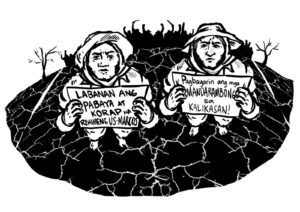Cagayanons suffer costs of offshore and black sand mining


From the outset, foreign offshore mining operations along the coasts of Cagayan in 2021 have caused tremendous damage to the livelihood of farmers and fishermen in the Cagayan Valley region.
Considered as the first and largest in the country, offshore mining in Cagayan cover 56,013 hectares of coastline and ocean in 10 towns in the region (Sanchez Mira, Claveria, Pamplona, Abulug, Ballesteros, Aparri, Buguey, Sta. Teresita, Gonzaga and Sta. Ana). The mined sand is source of magnetite, 100% of which is exported to China, serving as a key component in steel production.
Apollo Global Capital Inc, a Chinese company, controls the operation. It was granted a 25-year mining license by the Mines and Geosciences Bureau under the Duterte regime. The permit was granted to AGCI despite widespread and strong opposition to the project by local officials, environmental groups and residents. It disregarded the extensive and irreparable damage caused by offshore mining to the ecosystem not only in the proximity of its operation, but in the wider ocean as well.
It will destroy 50 hectares of reefs and seagrass forests of protected islands and oceans, such as the Palaui Island Protected Landscape and Seascape and the Babuyan Marine Corridor. These areas are home to dugongs, whales and many other endangered animals.
The company said their operations will not harm the environment, a claim debunked by researches and studies. Just drilling holes in the seabed to syphon the magnetite sand from the bottom already disrupts the ocean and all marine life. Dumping rocks and sand back into the sea after separating the mineral is also a major disturbance. Their ships also pose a danger to the communities along the coast of Gonzaga. In 2023, the dredger’s anchor chains broke due to the strong winds during Typhoon Egay. One of its supports fell and swept ashore.
Since the operations began, Gonzaga fishermen have been prohibited from fishing in the mine area. Due to the lingering effects of previous black sand mining operations along the town’s coast, they have been forced to fish elsewhere as there was nothing more to catch near the coast.
This affects the entire food security of the region. The mining operations covered the municipal waters (15 kilometers of ocean from the coast) which once produced 60.2% of Cagayan Valley’s fish supply.
Mining disguised as dredging
Cagayanons continue to suffer from the effects of black sand mining by the Riverfront Construction Inc in the Cagayan River under the guise of “dredging” of the Cagayan River Restoration Program.
In Aparri, the livelihood of 11,000 fisherfolk was affected by the relentless operation of dredegers and large vessels carrying stone and sand to China. They say the activities of these ships create noise and excessive light, and dump chemicals that disrupt the ecosystem causing the decline in the number of fish and aramang (small shrimp) that are the main source of their livelihood. The company digs in areas where they fish, far from the area designated for dredging.
Fisherfolk income dropped drastically since the “dredging” project began. Previously, five days of fishing could yield 200 containers of aramang, but now they are lucky to fill 50 containers. Similarly, a small boat could catch 200 kilos in one night’s fishing, but now it can only bring home three kilos. By 2022, their income dropped to ₱300 to ₱1,000 for a three-day fishing, a far cry from their previous income of ₱3,000 to ₱7,000.
Even the livelihood of vendors is affected. Before the project, the income of those who sun-dry and sell aramang and other fish reaches ₱8,000. Since 2021, their income from 5-day sales no longer reaches ₱700.









